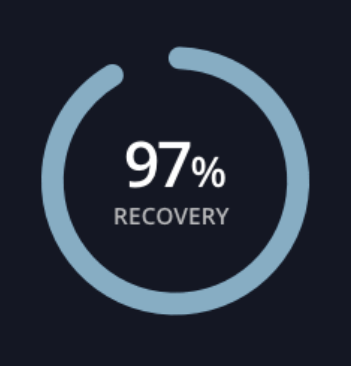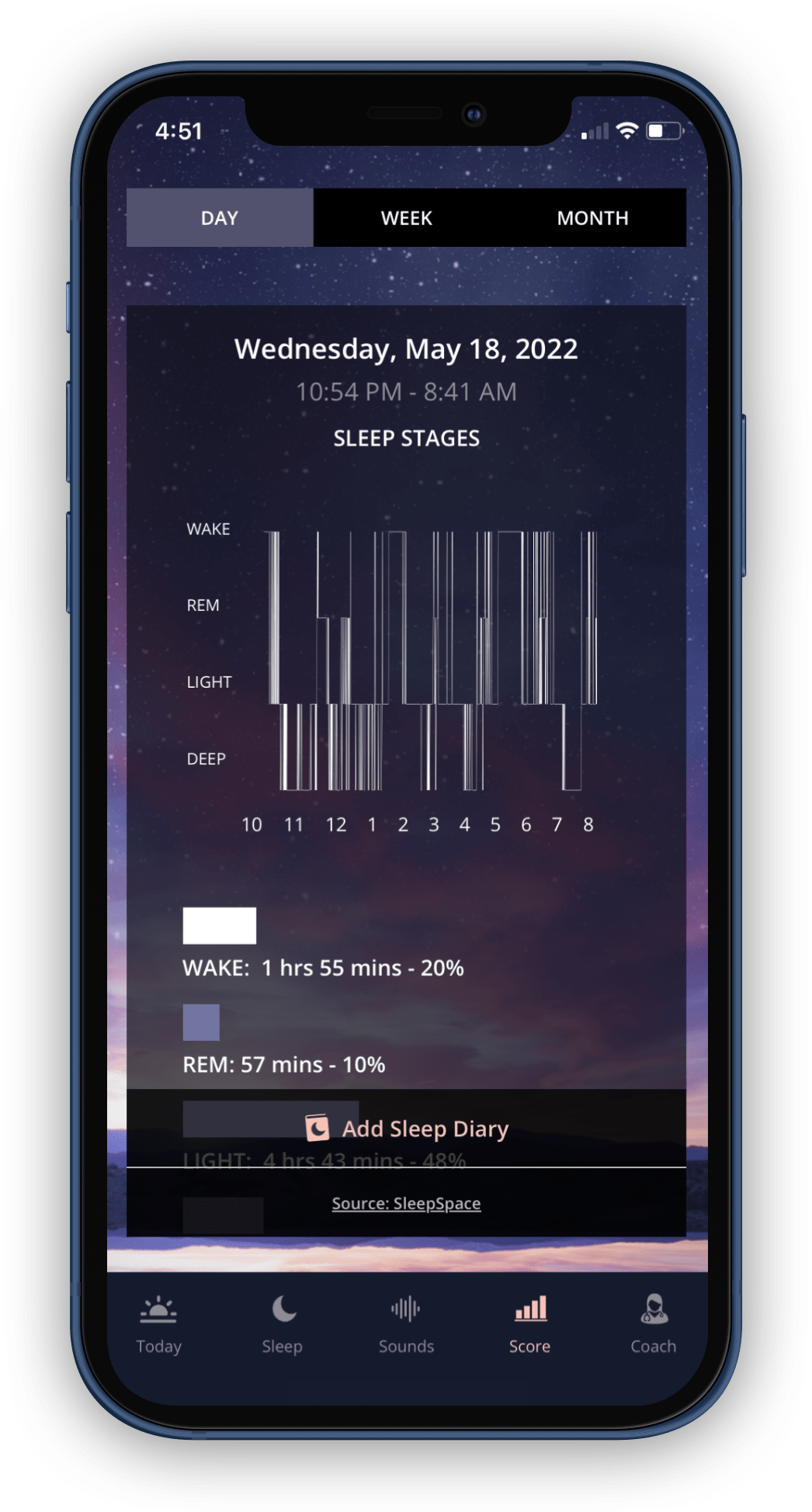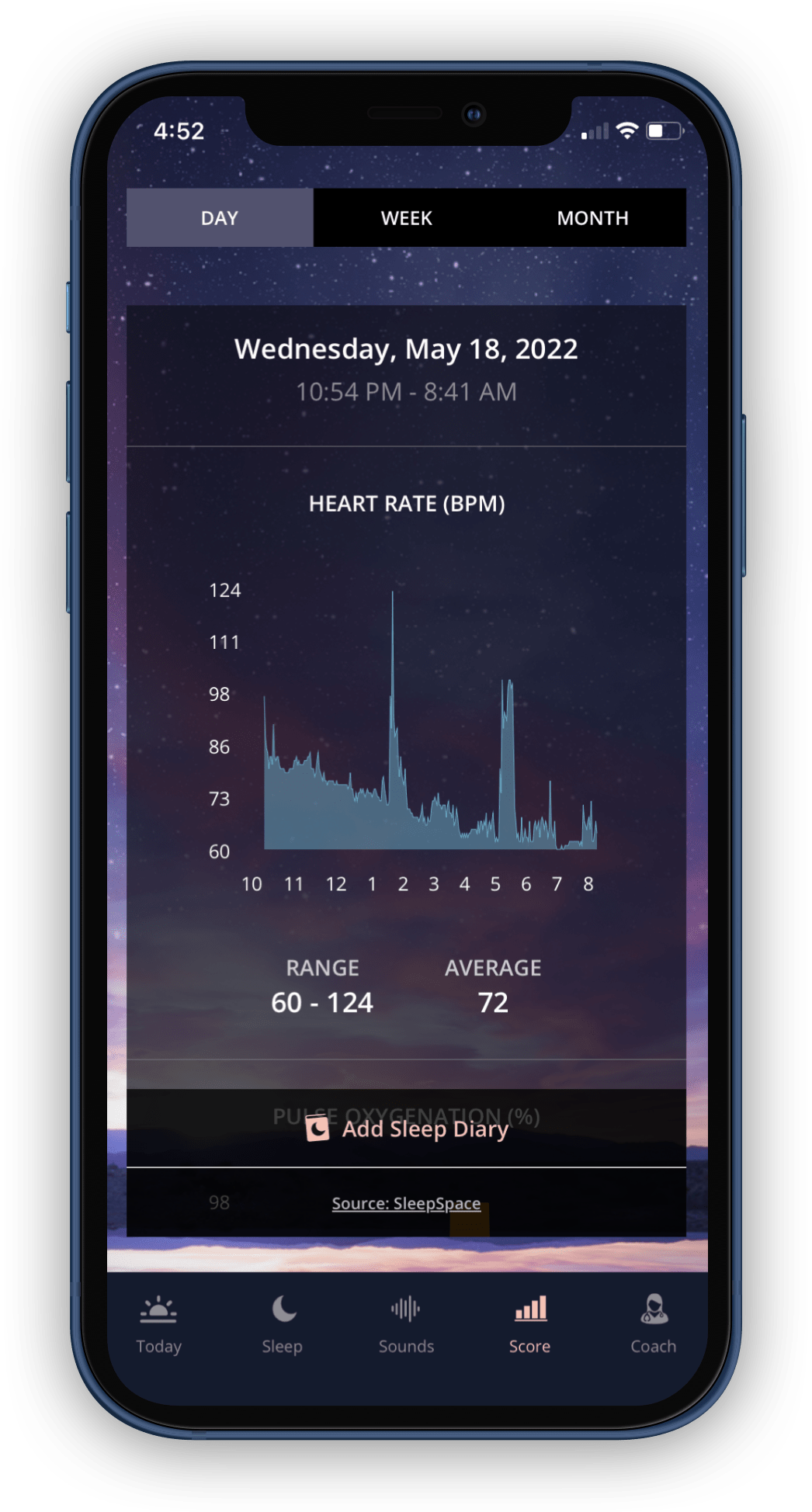Understanding your sleep score

Get a recovery score based on your unique sleep need
Recovery
Your recovery score represents how much your body has recharged from sleep and is based on the sleep health of the general population. We combine sleep amount and sleep quality to come up with your recovery score. If you are consistently getting more than 8 hours of sleep and you have high sleep efficiency (% of time in bed spent asleep), you may often find very high scores. If you are not getting enough sleep and are often awake during your designated sleep time then you will find that you frequently have lower scores. 90% of people need a recovery score between 70-100% on a regular basis. Some people need less recovery than others. This can actually be a sign of good health, not bad health since we need to sleep more when we are sick. If you think you are someone that needs less recovery where perhaps you may need closer to 7 hours than 8 hours, SleepSpace can uniquely adjust your recovery score. For iPhone users, go to the score screen and hit the gear. You will find your sleep need slider where you can adjust your sleep need from 6 hours to 9.5 hours. The greater your unique sleep need, the harder it will be to get a high recovery score.
Sleep Stages
We use your heart rate to measure your sleep quality and sleep stages. SleepSpace collects heart rate from any device that publishes heart rate data to Apple Health and can even combine data from multiple devices. However, you will only receive high resolution heart rate data if you go to the Sleep tab and press ‘Start my sleep session’. This turns your Apple Watch into a high resolution sleep tracker that can better measure your sleep quality. You can see how your heart rate changes with stage, usually becoming lower in deep sleep and higher in wake. Your resting heart rate during sleep is a good measure of overall health. You may notice that things like alcohol increase your average heart rate during sleep.

Time in Bed
Time in bed is the duration of time from when you indicate that you went to bed and when you indicate that you are out of bed in the morning. This does not represent when you are asleep, but instead when you are physically in bed. Oftentimes, people spend too much time in bed and this can have a negative impact on sleep because you start associating the bedroom with being awake.
Sleep Time
Sleep time is the amount of time spent in bed sleeping. Dividing this number by your time in bed gives you your sleep efficiency. For more accurate sleep tracking, try integrating with a wearable like the Apple Watch, Oura Ring, Whoop, Garmin, or Biostrap. A consensus report from leading sleep scientists in the field states that healthy adults need 7-9 hours of sleep on a regular basis.
Pro Tip: If you don’t like wearing something while you sleep, try our patented SleepSpace Smart Bed to accurately measure your sleep without having to wear an uncomfortable device. We call this innovative technology, “Nearable Sleep Sensing.”
Awakenings
Awakenings are measured when you spend at least 5 minutes awake in bed. These can be detected based on the motion of your phone or your wearable device.
Pro Tip: It is normal to have a few awakenings (2-3) throughout the night, but being awake for 20 minutes or more could be a sign that there are things you can do to improve your sleep quality. Chat with Dr. Snooze chatbot to figure out ways to reduce your awakenings at night.
Efficiency
Your sleep efficiency is how much you slept divided by how much time you spent in bed. Healthy sleep efficiency is typically between 85-95% throughout the night. If you are asleep more than 95% throughout the night, it could be a sign that you are not sleeping enough, though this is not always the case. If you frequently spend less than 85% of the time in bed asleep it may be a sign of insomnia. If you think this is relevant to you, please contact your healthcare professional.
Fall Asleep Time
We determine when you fall asleep based on when you spend 5 continuous minutes asleep in your bed. Keeping a consistent fall asleep time is a good way to strengthen your circadian rhythm and improve your sleep.
Wake Time
Your wake time happens at your final awakening for the day where you don't go back to sleep for more than 5 minutes. Spending a lot of time awake in bed is not a good way to maintain healthy sleep hygiene.


Sleep vs. Wake
One of the best measures of sleep quality is how much time in bed you spend sleeping. Sleep amount divided by time in bed represents your sleep efficiency. The Sleep vs. Wake graph shows you when you are in bed asleep. The more consolidated your sleep, the more healthy your circadian rhythm. But be aware that spending 95% or more time in bed could be a sign that you are not getting enough sleep. It’s considered healthy to spend between 85-95% of time in bed asleep.
Heart Rate
We use your heart rate to measure your sleep quality and sleep stages. SleepSpace collects heart rate from any device that publishes heart rate data to Apple Health and can even combine data from multiple devices. However, you will only receive high resolution heart rate data if you go to the Sleep tab and press ‘Start my sleep session’. This turns your Apple Watch into a high resolution sleep tracker that can better measure your sleep quality. You can see how your heart rate changes with stage, usually becoming lower in deep sleep and higher in wake. Your resting heart rate during sleep is a good measure of overall health. You may notice that things like alcohol increase your average heart rate during sleep.
Pulse Oxygenation
Your pulse oxygenation can help you understand how well you are breathing throughout the night. One major cause of poor sleep quality is when you have obstructed breathing. Healthy breathing involves pulse oxygenation values greater than 90% on a regular basis and your average should be in the mid-90s typically. If your average is consistently in the 80% range, then you may want to seek a health professional. This feedback does not constitute anything medical and is designed for informational purposes.
Heart Rate
Heart rate variability (HRV) is one of the most useful ways to evaluate your recovery. People often report elevated HRV when fighting off a virus or infection. SleepSpace is one of the most accurate estimates of HRV on the Apple Watch. By enabling high sampling mode on the Apple Watch, we can record heart rate values every 5 seconds. From these values, we are able to estimate your HRV by measuring the variability of your heart rate and covering that into the milliseconds between your heart rates. You may notice that during deep sleep, you have a lower HRV than when you are awake. This is considered normal and healthy.
Sound in Room
We measure sound room in decibels (DB) to detect sound disruptions in your bedroom environment, such as snoring and noise position. We have found when investigating the science of sleep that even a seemingly harmless sound like an air conditioner can wake you up during sleep without your awareness. Abrupt sounds are the main culprit of those awakenings. Try using a sound mask in the Sounds section to mitigate the disruptive impact of noise pollution on your sleep.
Phone Motion
We measure your phone motion in terms of gravitational acceleration (g). Using your phone at night is one of the main causes of poor sleep health. Our phones have become devices that activate, cause stress, and expose us to harmful blue light that keeps us awake. The phone motion measure determines if you are using your phone too much at night and also identifies awakenings. Additionally, if you are using the SleepSpace Smart Bed, we use micro-motions from your phone to accurately measure your sleep.